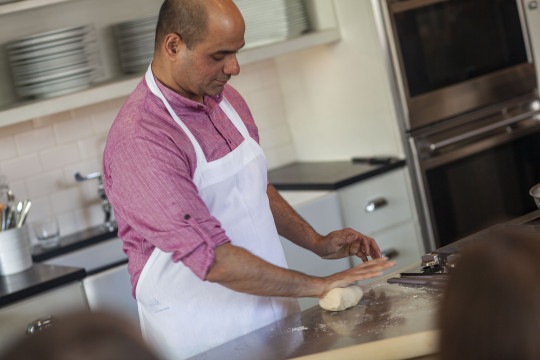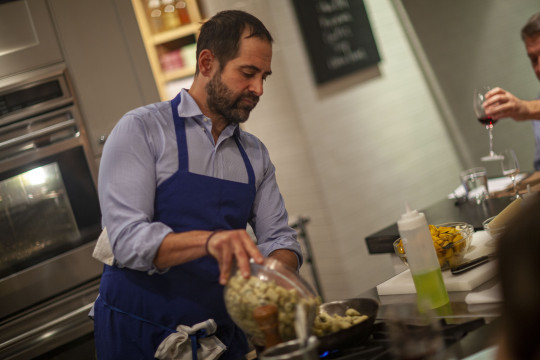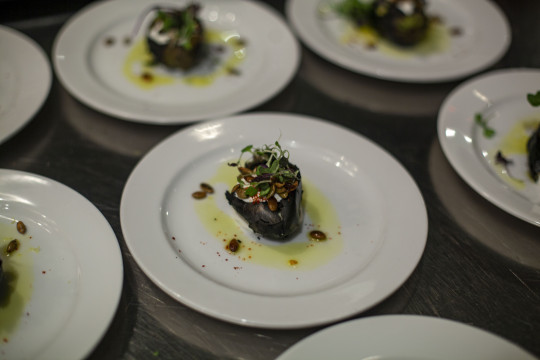From making flavorful herbal beverages to producing an ever so simple dessert, February’s visiting chefs gave us some great insights. As March draws near, it’s time to take a look back at some of our favorite tips and tricks.
Tip #1: What’s the tea?
Tea in the morning, tea in the afternoon, tea all the time. That’s the Indian way. And there is only one style of tea that you will find across India and in the homes of migrants worldwide: chai. While many might think chai is a type of tea leaf, it’s simply the Indian word for the style of preparation. When Rupen Rao visited on Sunday afternoon, he was sure to bring his mom’s favorite recipe – albeit with a very special (and expensive) ingredient.
Kesar Chai (Saffron Chai)
Serves 4 (6 oz servings)
1 1/2 cups hot water
1/2 tsp ground cardamom
1/2 tsp ground saffron
3 tsp black loose tea leaves
4 tsp sugar
2/3 cup warm whole milk
In a 3-qt saucepan over medium heat, boil water, cardamom and saffron. Add tea leaves and sugar. Bring to a boil again. Cook for 2 minutes.
Add milk, stir, and bring to a boil again. Reduce heat to low and cook for 5 minutes. Strain and serve in teacups.
Tip #2: I am the eggmanplant
A chef once told me “You can’t say you don’t like something, you can only say you don’t like how you’ve had it.” While I don’t agree with telling people what to think, encouraging them to expand their horizons is a noble gesture. And in this instance, I think the statement is spot on. Jonathan Dearden of Red Owl Tavern learned that lesson with eggplant. You see, it’s his least favorite vegetable. To him, the texture is weird, and it can be flavorless. Instead of just giving up on them, he found that he liked a smokey, charred version. Taking baby eggplants and an open flame results in a dish that he loves to share. This could easily be the base for your next baba ghanoush.
Tip #3: Rhum, baba, rhum
Making dessert can be a big hurdle for some. Feeling like “I can’t bake” or “it never turns out right” is real, and I totally empathize with that sentiment. For an easy no-bake solution, Kenny Bush of Gabi dropped some knowledge on us: baba au rhum. This classic French dessert can certainly be made with homemade baba, or you can skip that step by buying any bread, muffin, or pastry. Take your dried (maybe slightly stale) “baba” and soak it in a rum syrup (put 3 cups of water, 2 cups of sugar, and 2/3 cups of dark rum into a saucepan and reduce, finishing with 1 1/2 teaspoons of vanilla). Top with your favorite nuts or preserves.
Tip #4: Get in my (pork) belly!
I can imagine that Fat Bastard would’ve been a fan of porchetta. If you’re not familiar with the Italian favorite, it is basically pork loin wrapped inside of pork belly. The two parts are often butchered separately. However, Chad Durkin of Porcos Porchetteria suggests planning ahead and reaching out to your favorite butcher to ask for the “porchetta cut.” This ensures that the pieces fit well together and you will not lose any product by having to trim it. Additionally, your meat may come from two different pigs if you purchase them separately. Depending on where you’re getting it from, this could alter the quality of your finished product.
Tip #5: Hot Potato
Ah, the potato. Is there a more versatile vegetable? You probably have a favorite iteration. Mine is easily french fries with home fries as a very close second. Fries come in so many forms today that you can spark a debate by suggesting that your favorite reigns supreme. No matter what, one thing is true though: the perfect fry is nicely salted and crunchy on the outside while hot and soft on the inside. The only real way to consistently achieve that, according to Brian Ricci of Philadelphia Community Kitchen, is to blanch them first before they hit the fryer. Giving them a quick salted water boil for about 10 minutes will do wonders for your finished product. You’ll want 3 grams of salt for every 100 milliliters of water when par-cooking your papas.
Happy cooking!
Back to Blog




